
Buyer intent data captures real-time signals indicating a prospect's readiness to purchase, enabling targeted sales strategies that prioritize high-intent leads. Customer journey mapping visualizes the complete buying process, identifying touchpoints and pain points to optimize engagement and conversion rates. Explore deeper insights into leveraging both tools to accelerate your sales pipeline and close deals efficiently.
Why it is important
Understanding the difference between buyer intent data and customer journey mapping is crucial because buyer intent data reveals real-time signals of purchase readiness, enhancing targeted sales strategies. Customer journey mapping provides a comprehensive view of the entire buying process, allowing businesses to tailor interactions and improve customer experience. Accurate use of buyer intent data can increase lead conversion rates by identifying high-potential prospects. Integrating both approaches maximizes sales efficiency and drives revenue growth.
Comparison Table
| Feature | Buyer Intent Data | Customer Journey Mapping |
|---|---|---|
| Definition | Data showing a prospect's purchasing signals and content consumption patterns. | Visual representation of a customer's interactions and experiences with a brand. |
| Purpose | Identify active buyers and predict purchase readiness. | Understand and improve customer experience at each touchpoint. |
| Data Source | Behavioral signals, web activity, search queries, content engagement. | Customer feedback, analytics, sales interactions, touchpoints analysis. |
| Focus | Intent and timing of purchase decisions. | Customer experience lifecycle and journey phases. |
| Usage in Sales | Target high-intent prospects with personalized outreach. | Design strategies to enhance customer satisfaction and retention. |
| Benefits | Improved lead qualification and conversion rates. | Better customer insights and optimized engagement paths. |
| Timeframe | Real-time or near real-time data. | Longitudinal view over the entire customer lifecycle. |
Which is better?
Buyer intent data provides real-time insights into potential customers' behaviors, enabling targeted sales strategies that increase conversion rates. Customer journey mapping offers a comprehensive view of the entire buying process, helping sales teams identify pain points and optimize touchpoints for improved customer experience. Combining both approaches maximizes sales effectiveness by aligning marketing efforts with customer needs and decision-making stages.
Connection
Buyer intent data provides insights into potential customers' behaviors and interests, enabling precise identification of purchasing signals throughout the customer journey. Customer journey mapping utilizes this data to visualize touchpoints and optimize engagement strategies at each stage. Integrating buyer intent data with journey mapping enhances targeted sales efforts and improves conversion rates significantly.
Key Terms
Customer Journey Mapping:
Customer journey mapping visually outlines each interaction a customer has with a brand, enabling businesses to identify pain points, optimize touchpoints, and enhance overall user experience. It captures the emotional and behavioral patterns of customers across various stages such as awareness, consideration, and decision, offering deeper insights into customer motivations and preferences. Discover how customer journey mapping can transform your marketing strategy and improve customer satisfaction.
Touchpoints
Customer journey mapping identifies and visualizes all touchpoints a customer interacts with throughout their purchasing process, providing a comprehensive understanding of the customer's experience and pain points. Buyer intent data captures real-time signals and behavioral patterns at specific touchpoints, predicting a prospect's readiness to purchase by analyzing online activity, content consumption, and engagement metrics. Explore how integrating customer journey mapping with buyer intent data enhances touchpoint optimization for more precise targeting and conversion strategies.
Personas
Customer journey mapping visualizes the steps customers take from awareness to purchase, highlighting touchpoints and emotional states to create detailed buyer personas. Buyer intent data reveals real-time signals and behavioral patterns indicating a prospect's readiness to buy, enabling targeted engagement based on persona-specific needs. Explore how integrating these strategies can enhance persona accuracy and boost conversion rates.
Source and External Links
The customer journey map and why it's important - A customer journey map is a visual representation of all contact points between a customer and a company throughout their relationship, created by setting clear goals, developing customer personas, and identifying touchpoints across the buying process to improve customer experience and reduce friction.
What is a Customer Journey Map? - IBM - A customer journey map charts every experience a customer has with a brand, highlighting key stages, touchpoints, customer emotions, pain points, and validating insights with real customers to enhance understanding and align marketing efforts.
30 Best Customer Journey Mapping Tools of 2025 - Customer journey mapping involves tracking how customers discover, purchase, use, and churn with products, supported by analytics and customer feedback, and can be created with digital or physical tools depending on the business model to better understand and improve customer engagement and retention.
 dowidth.com
dowidth.com